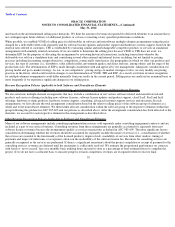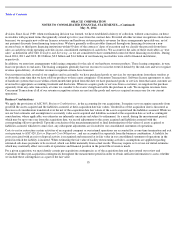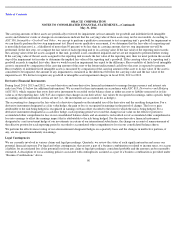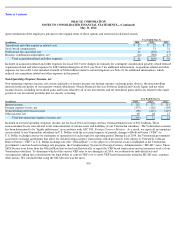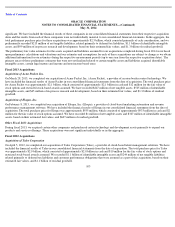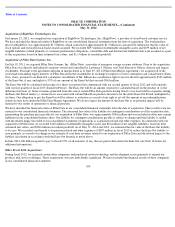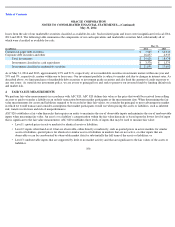Oracle 2013 Annual Report Download - page 105
Download and view the complete annual report
Please find page 105 of the 2013 Oracle annual report below. You can navigate through the pages in the report by either clicking on the pages listed below, or by using the keyword search tool below to find specific information within the annual report.
Table of Contents
ORACLE CORPORATION
NOTES TO CONSOLIDATED FINANCIAL STATEMENTS—(Continued)
May 31, 2014
appropriate for our reporting of our Venezuelan subsidiary’s VEF based transactions and net monetary assets in U.S. Dollars, which resulted in
the fiscal 2014 remeasurement losses referenced above. During fiscal 2013, we also incurred a foreign currency remeasurement loss of $64
million related to our Venezuelan subsidiary due to the devaluation of the VEF official exchange rate by the Venezuelan government. Future
devaluations of the Venezuelan currency are not expected to have a significant impact on our consolidated financial statements. As a large
portion of our consolidated operations are international, we could experience additional foreign currency volatility and incur additional
remeasurement losses in the future, the amounts and timing of which are unknown.
Income Taxes
We account for income taxes in accordance with ASC 740, Income Taxes . Deferred income taxes are recorded for the expected tax
consequences of temporary differences between the tax bases of assets and liabilities for financial reporting purposes and amounts recognized for
income tax purposes. We record a valuation allowance to reduce our deferred tax assets to the amount of future tax benefit that is more likely
than not to be realized.
A two-
step approach is applied pursuant to ASC 740 in the recognition and measurement of uncertain tax positions taken or expected to be taken
in a tax return. The first step is to determine if the weight of available evidence indicates that it is more likely than not that the tax position will
be sustained in an audit, including resolution of any related appeals or litigation processes. The second step is to measure the tax benefit as the
largest amount that is more than 50% likely to be realized upon ultimate settlement. We recognize interest and penalties related to uncertain tax
positions in our provision for income taxes line of our consolidated statements of operations.
A description of our accounting policies associated with tax related contingencies and valuation allowances assumed as a part of a business
combination is provided under “Business Combinations” above.
Recent Accounting Pronouncements
Share
-Based Payments with Performance Targets: In June 2014, the FASB issued Accounting Standards Update No. 2014-12, Accounting
for Share
-Based Payments When the Terms of an Award Provide That a Performance Target Could Be Achieved after the Requisite Service
Period
(ASU 2014-12). ASU 2014-12 requires that a performance target that affects vesting and could be achieved after the requisite service
period be treated as a performance condition. A reporting entity should apply existing guidance in ASC 718, Compensation — Stock
Compensation , as it relates to such awards. ASU 2014-12 is effective for us in our first quarter of fiscal 2017 with early adoption permitted
using either of two methods: (i) prospective to all awards granted or modified after the effective date; or (ii) retrospective to all awards with
performance targets that are outstanding as of the beginning of the earliest annual period presented in the financial statements and to all new or
modified awards thereafter, with the cumulative effect of applying ASU 2014-12 as an adjustment to the opening retained earnings balance as of
the beginning of the earliest annual period presented in the financial statements. We are currently evaluating the impact of our pending adoption
on ASU 2014-12 on our consolidated financial statements.
Revenue Recognition:
In May 2014, the FASB issued Accounting Standards Update No. 2014-09, Revenue from Contracts with Customers:
Topic 606 (ASU 2014-09), to supersede nearly all existing revenue recognition guidance under U.S. GAAP. The core principle of ASU 2014-09
is to recognize revenues when promised goods or services are transferred to customers in an amount that reflects the consideration that is
expected to be received for those goods or services. ASU 2014-09 defines a five step process to achieve this core principle and, in doing so, it is
possible more judgment and estimates may be required within the revenue recognition process than required under existing U.S. GAAP
including identifying performance obligations in the contract, estimating the amount of variable consideration to include in the transaction price
and allocating the transaction price to each separate performance obligation. ASU 2014-09 is effective for us in our first quarter of fiscal 2018
using either of two methods: (i) retrospective to each prior reporting period presented with the option to elect
101




